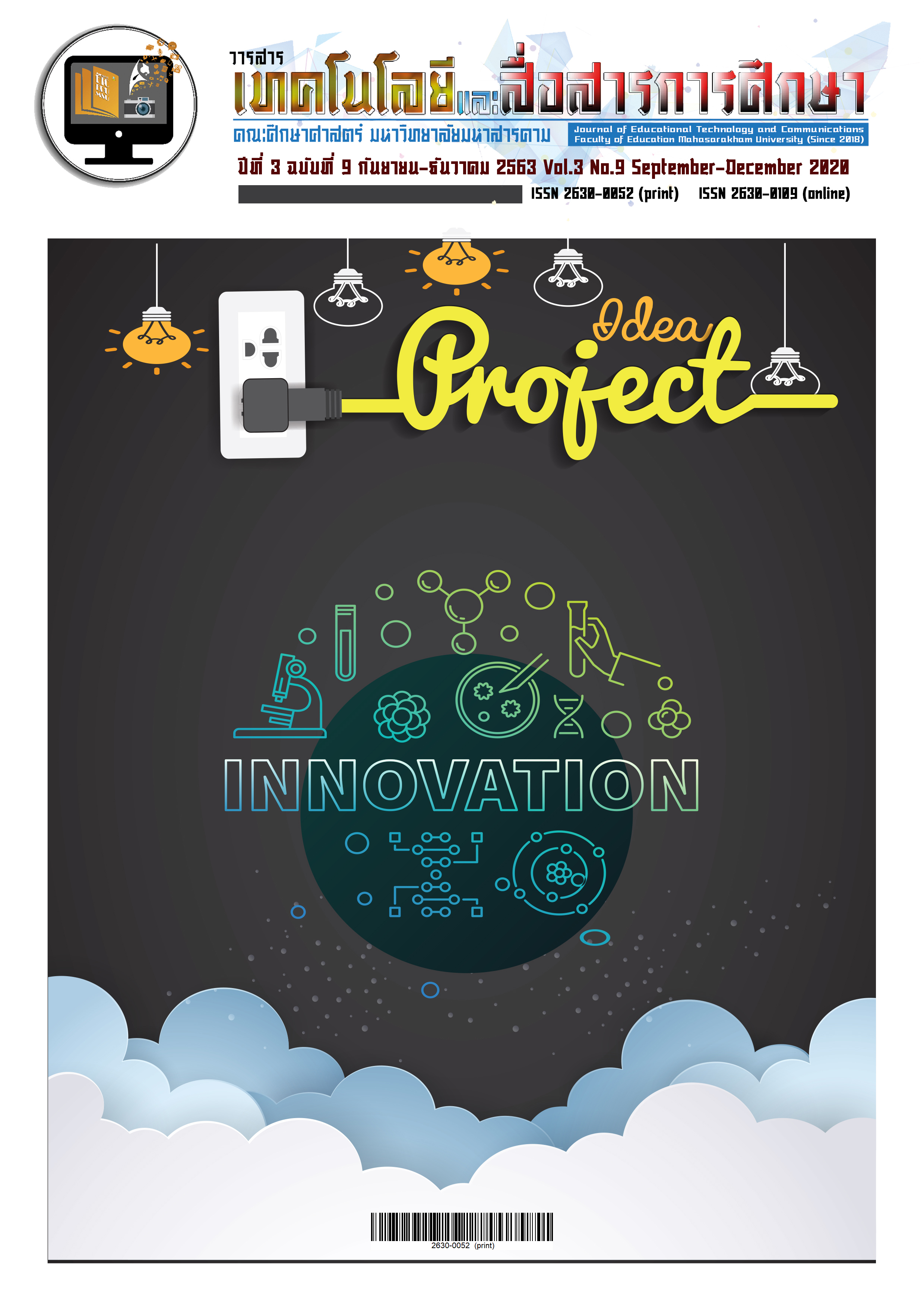Collaborative Learning Development by Means of STAD Technique Supplemented with Augmented Reality-Applied Books Entitled “Human Growth and Development” for Prathom 6 Students
Main Article Content
Abstract
ABSTRACT
The purposes of this study are (1) to find the efficiency of Augmented Reality Books based on the 80/80 criteria; (2) to find the effectiveness index outcome of Augmented Reality-Applied Books; (3) to compare the testing scores between pre-test and post-test scores, by employing the STAD Technique Supplemented with Augmented Reality-Applied Books, according to the specified criteria; (4) to study group process skills, applying the STAD Technique Supplemented with Augmented Reality-Applied Books and (5) to study student satisfaction towards the STAD Technique Supplemented with Augmented Reality-Applied Books Entitled “Human Growth and Development” for Prathom 6 Students of Kalasinpittayasai School, Kalasin Province, with 48 students. Tools of this study include 5 items, namely, the efficiency of STAD-Cooperative Learning Method applying Augmented Reality Technology, the effectiveness index outcome, the comparison of learning achievements and a satisfaction evaluation form. Statistics for data analysis comprise of Mean () and standard deviation (S.D.) and a statistic for hypothesis testing is T-Test (Dependent Samples). The statistical significance was determined at .05
The research results are as follows.
- Effectiveness procedure is equal to 84.79/80.69
- Effectiveness index outcome is equal to 0.6538, accounted for 65.38 percent
- The testing scores between pre-test and post-test scores are statistically significant differences at the level .05
- Group process skills are at good level, with a mean (
) of 4.33 and standard deviation (S.D.) of 2.09
- Satisfaction towards the STAD Technique Supplemented are at very good level, with a mean (
) of 4.86 and standard deviation (S.D.) of 0.14
Downloads
Article Details
References
ชวนพิศ จะรา. (2556) การพัฒนาการเรียนด้วยเทคโนโลยีผสานความจริง (AR) ร่วมกับหนังสือนิทานสองภาษาโดยใช้กระบวนการกลุ่ม
เพื่อส่งเสริมความสามารถทางภาษาด้านการฟังและการพูดของเด็กปฐมวัย. วิทยานิพนธ์ มหาวิทยาลัยเทคโนโลยี พระจอมเกล้าธนบุรี
ชัยยงค์ พรหมวงศ์. (2556). “การทดสอบประสิทธิภาพสื่อหรือชุดการสอน”, วารสารศิลปากรศึกษาศาสตร์วิจัย. 5(1), 7-20
ไชยยศ เรืองสุวรรณ. (2552). เทคโนโลยีการสอน: การออกแบบและพัฒนา. กรุงเทพฯ: โอเดียนสโตร์.
ณัฐฐาน์ นิธิภัทร์มณีโชค (2559) บทเรียนคอมพิวเตอร์ช่วยสอน เรื่อง ระบบหมุนเวียนโลหิต ด้วยเทคโนโลยีเสมือนจริง Computer
Assisted Instruction on Circulatory system with an Augmented Reality วารสารมนุษยศาสตร์และสังคมศาสตร์ มหาวิทยาลัยราชพฤกษ์ 2 ( 2) มิถุนายน–กันยายน 101-112
ธีรเดช บุญนภา และคณะ. (2558). “การพัฒนาสื่อการเรียนการสอนด้วยเทคโนโลยีความเป็นจริงเสริมแต่งบนระบบ ปฏิบัติการ
แอนดรอยด์.” The 3 rd ASEAN Undergraduate Conference in Computing (AUC2)
ประพันธ์ศิริ สุเสารัจ. (2540). “กระบวนการกลุ่ม.” ในทฤษฎีการเรียนรู้แบบมีส่วนร่วม :ต้นแบบการเรียนรู้ทางด้านหลักทฤษฎีและแนว
ปฏิบัติ. หน้า40. กรุงเทพฯ : สำนักงานคณะกรรมการการศึกษาแห่งชาติ.
ปิ่นสุดา มังคะรัตน์ (2561) การพัฒนาชุดการเรียนรู้แบบจำลองสถานการณ์เพื่อเสริมสร้างทักษะภาษาอังกฤษโดยใช้เทคโนโลยี AR
(Augmented Reality) สำหรับนักเรียนชั้นประถมศึกษาปีที่ 4 วิทยานิพนธ์ (กศ.ม. เทคโนโลยีและสื่อสารการศึกษา) มหาวิทยาลัยมหาสารคาม,
วิจารณ์ พานิช. (2554 ). วิถีสร้างการเรียนรู้เพื่อศิษย์ในศตวรรษที่21. กรุงเทพฯ : ตถาตาพลับลิเคชั่น จำกัด.
สมบัติ ท้ายเรือคำ. (2553). วิธีการทางสถิติสำหรับการวิจัย. มหาสารคาม. ภาควิชาวัดผลและวิจัยการศึกษา คณะศึกษาศาสตร์:
มหาวิทยาลัยมหาสารคาม.
สุคนธ์ สินธพานนท์ และคณะ. (2551). นวัตกรรมการเรียนการสอนเพื่อพัฒนาคุณภาพของเยาวชน. พิมพ์ครั้งที่: 2. กรุงเทพฯ :
โรงพิมพ์ 9119 เทนนิคพริ้นติ่ง.
อนุชาวดี ไชยทองศรี (2559) การพัฒนาทักษะการเรียนรู้และผลสัมฤทธิ์ทางการเรียนของนักศึกษาในการเรียน วิชาภาษาจาวา โดยใช้
เทคนิคการเรียนรู้แบบมีส่วนร่วม (Active Learning) เน้นการฝึกปฏิบัติด้วยกระบวนการกลุ่ม งานวิจัยงบประมาณรายได้ปี 2560 มหาวิทยาลัยเทคโนโลยีราชมงคลอีสาน วิทยาเขตสกลนคร
อภิวัฒน์ โตชัยภูมิ (2559) การพัฒนาผลสัมฤทธ์ิทางการเรียน เรื่อง ความปลอดภัยในชีวิต กลุ่มสาระการเรียนรู้ สุขศึกษา และพลศึกษา
ชั้นมัธยมศึกษาปี ที่ 2 โดยใช้การจัดการเรียนรู้แบบร่วมมือเทคนิค STAD วิทยานิพนธ์ ปริญญาครุศาสตรมหาบัณฑิต สาขาวิชาหลักสูตรและการเรียนการสอน บัณฑิตวิทยาลัย มหาวิทยาลัยราชภัฏมหาสารคาม

